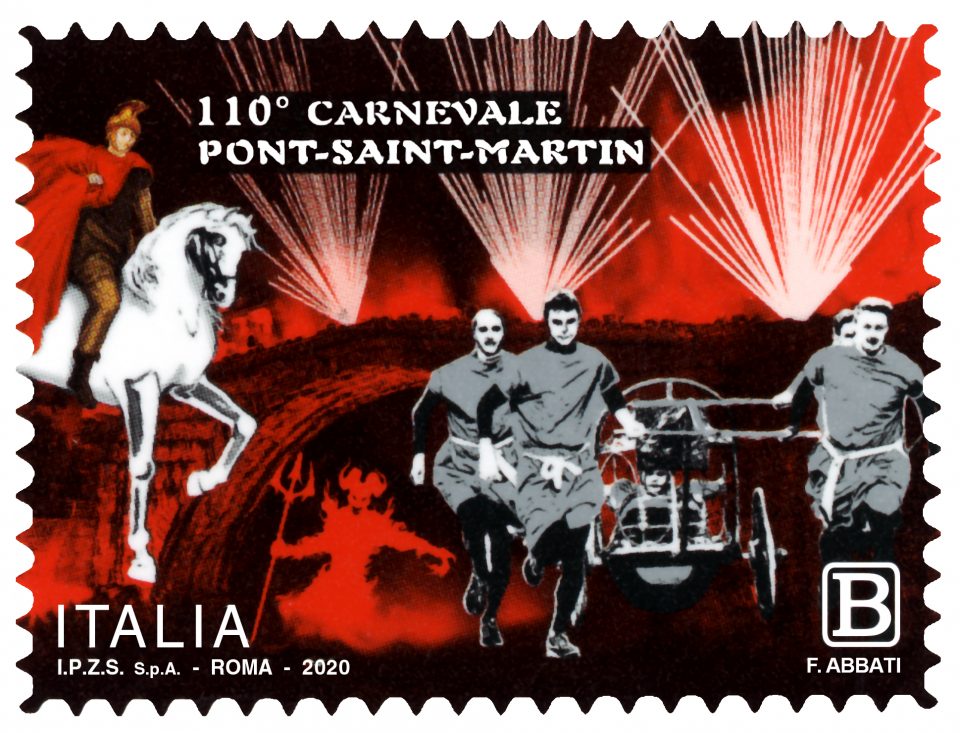POSTE ITALIANE 6^ emissione del 20 Febbraio 2020 di un francobollo dedicato al Carnevale di Pont- Saint-Martin, nella 110° edizione
POSTE ITALIANE 6^ emissione del 20 Febbraio 2020 di un francobollo dedicato al Carnevale di Pont- Saint-Martin, nella 110° edizione

Il Ministero dello Sviluppo ha emesso il 20 febbraio 2020 un francobollo ordinario appartenente alla serie tematica “le Festività” dedicato al Carnevale di Pont-Saint-Martin, nella 110° edizione, relativo al valore della tariffa B, corrispondente ad €1.10.
- data / date 20 febbraio 2020
- dentellatura / serration 11
- stampa / printing rotocalcografia
- tipo di carta / paper type su carta bianca autoadesiva
- stampato / printed I.P.Z.S. Roma
- tiratura / edition 500.000
- dimensioni / dimension 40 x 30 mm (stamp)
- costo / price B = € 1.10 Stamp
- bozzettista/ designer Fabio ABBATI
- num. catalogo/catalog num. Michel 4188 YT 3949 UNIF 4031
Pont-Saint-Martin è un comune italiano di circa 3.700 abitanti della Valle d’Aosta sudorientale. Dal 1929 al 1946 la località ebbe il nome italianizzato di Ponte San Martino.
Territorio
Situato all’imbocco della Valle d’Aosta, alla base della valle del Lys, conserva nei suoi pressi i resti dell’antica strada romana per le Gallie detta via delle Gallie. Pont-Saint-Martin costituisce una tappa della via Francigena, proveniente dal colle del Gran San Bernardo, prima di entrare in Piemonte e dirigersi tra i vigneti verso Carema.
Attraversato dalla Dora Baltea, sorge nella estrema parte orientale della plaine di Donnas e dista 40 km da Aosta. Il territorio comunale comprende una parte urbanizzata, situata tra i 300 e i 400 metri di quota sulla conoide di deiezione creata dallo sbocco del torrente Lys nel solco principale della Valle d’Aosta, e una zona montana che si estende verso est e dove si tocca la quota massima con il Bec di Nona (2085 m).
Storia
Da Pont-Saint-Martin, in epoca romana, passava la via delle Gallie, strada romana consolare fatta costruire da Augusto per collegare la Pianura Padana con la Gallia. Passaggio obbligato lungo la via delle Gallie e successivamente lungo la Via Francigena, Pont-Saint-Martin nel 575 si trovò al confine del regno dei Franchi.
Nel Medioevo fu amministrato dalla signoria locale, i Signori di Bard, che nel 1200 fecero erigere il castello di Pont-Saint-Martin, che ancora sovrasta il paese. Durante la Seconda guerra mondiale, nel 1944, l’abitato fu devastato da un bombardamento, ma il ponte romano resistette.
La leggenda
Secondo la leggenda, San Martino, di passaggio sulla via Francigena in pellegrinaggio, fece un patto con il diavolo. Questi si impegnò a costruire in una notte un ponte, in cambio dell’anima del primo essere vivente che ci sarebbe passato. Il giorno dopo, San Martino liberò sul ponte un cagnolino, che venne ucciso brutalmente. In compenso, il diavolo lasciò in pace gli abitanti.
Questa leggenda fa parte del ricco repertorio della valle del Lys, e rivive ogni anno nel carnevale storico.
Il Pont Saint-Martin
L’abitato prende il nome dal poderoso ponte romano dedicato a San Martino di Tours, che attraversa il torrente Lys. Costruito nel I secolo a.C., nel corso di quasi 2.000 anni ha consentito il passaggio dalla regione di Eporedia (l’attuale Ivrea) verso la Valle d’Aosta. Il ponte è lungo 31 m e alto 23 m. Fu utilizzato fino al XIX secolo, poi venne costruito un ponte moderno.
Il carnevale storico di Pont-Saint-Martin
Nel carnevale di Pont-Saint-Martin, i personaggi principali sono rappresentati dal diavolo, da San Martino, dalla ninfa del Lys, dai Romani e dai Salassi.
Vi è inoltre la sfilata dei costumi tradizionali delle sette insulæ, i quartieri storici del borgo, con i loro nomi in latino:
- Fundus Tauri ;
- Insula Vernæ ;
- Insula Leonis ;
- Platea Primus Maius ;
- Insula Pontis Romani ;
- Vicus Colubris ;
- Insula Saint-Roch
Ha luogo in seguito la corsa delle bighe, una per ogni insula. Il carnevale si conclude il “mardi gras“, quando un fantoccio del diavolo viene bruciato dal ponte romano sul Lys, in ricordo della leggenda
Se sei interessato all’acquisto di questo francobollo lo puoi acquistare al prezzo di € 1.50. Inviami una richiesta alla email: protofilia1@gmail.com
ITALIAN POSTS 6th issue of 20 February 2020 of a stamp dedicated to the Carnival of Pont-Saint-Martin, in the 110th edition

On February 20, 2020 the Ministry of Development issued an ordinary stamp belonging to the thematic series “the Holidays” dedicated to the Carnival of Pont-Saint-Martin, in the 110th edition, relating to the value of tariff B, corresponding to € 1.10.
- data / date 20 febbraio 2020
- dentellatura / serration 11
- stampa / printing rotocalcografia
- tipo di carta / paper type su carta bianca autoadesiva
- stampato / printed I.P.Z.S. Roma
- tiratura / edition 500.000
- dimensioni / dimension 40 x 30 mm (stamp)
- costo / price B = € 1.10 Stamp
- bozzettista/ designer Fabio ABBATI
- num. catalogo/catalog num. Michel YT UNIF 4031
Pont-Saint-Martin is an Italian town of about 3,700 inhabitants in the southeast Valle d’Aosta. From 1929 to 1946 the town had the Italianized name of Ponte San Martino.
Territory
Located at the entrance of the Aosta Valley, at the base of the Lys valley, it preserves in its vicinity the remains of the ancient Roman road to the Gallie called via delle Gallie. Pont-Saint-Martin constitutes a stop on the Via Francigena, coming from the Gran San Bernardo hill, before entering Piedmont and heading among the vineyards towards Carema.
Crossed by the Dora Baltea, it rises in the extreme eastern part of the plains of Donnas and is 40 km from Aosta. The municipal area includes an urbanized part, located between 300 and 400 meters above sea level on the dejection fan created by the outlet of the Lys torrent in the main furrow of the Aosta Valley, and a mountain area that extends towards the east and where the maximum altitude with Bec di Nona (2085 m).
History
From Pont-Saint-Martin, in Roman times, the Via delle Gallie passed, the Roman consular road built by Augustus to connect the Po Valley with Gaul. Forced passage along the Via delle Gallie and subsequently along the Via Francigena, Pont-Saint-Martin in 575 found himself on the border of the Frankish kingdom.
In the Middle Ages it was administered by the local lordship, the Lords of Bard, who in 1200 built the castle of Pont-Saint-Martin, which still dominates the town. During the Second World War, in 1944, the town was devastated by bombing, but the Roman bridge resisted.
The legend
According to legend, San Martino, passing through the Via Francigena on a pilgrimage, made a pact with the devil. He undertook to build a bridge overnight, in exchange for the soul of the first living thing that would pass there. The next day, San Martino released a dog on the bridge, who was brutally killed. On the other hand, the devil left the inhabitants alone.
This legend is part of the rich repertoire of the Lys valley, and lives again every year in the historical carnival.
The Pont Saint-Martin
The town takes its name from the mighty Roman bridge dedicated to San Martino di Tours, which crosses the Lys torrent. Built in the first century BC, over the course of almost 2,000 years, it allowed the passage from the region of Eporedia (today’s Ivrea) to the Valle d’Aosta. The bridge is 31 m long and 23 m high. It was used until the 19th century, then a modern bridge was built.
The historical carnival of Pont-Saint-Martin
In the Pont-Saint-Martin carnival, the main characters are represented by the devil, San Martino, the nymph of the Lys, the Romans and the Salassi.
There is also the parade of traditional costumes of the seven insulæ, the historic districts of the village, with their names in Latin:
• Fundus Tauri;
• Insula Vernæ;
• Insula Leonis;
Platea Primus Maius;
• Insula Pontis Romani;
• Vicus Colubris;
• Insula Saint-Roch
The chariot race then takes place, one for each insula.
The carnival ends on “mardi gras”, when a devil puppet is burned by the Roman bridge over the Lys, in memory of the legend
If you are interested in purchasing this stamp, you can buy it at a price of € 1.50. Send me a request to the email: protofilia1@gmail.com







